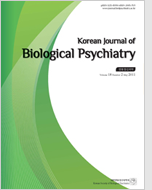
- Past Issues
- e-Submission
-

2021 Impact Factor 1.766
5-Year Impact Factor 1.674
Editorial Office
- +82-01-9989-7744
- kbiolpsychiatry@gmail.com
- https://www.biolpsychiatry.or.kr/

2021 Impact Factor 1.766
5-Year Impact Factor 1.674
Korean Journal of Biological Psychiatry 2015;22(4):187-94. Published online: Apr, 1, 2015
Objectives :
To examine direct causes of attempted suicides, methods adopted to commit suicide, and psychiatric diagnoses among suicide attempters in South Korea.
Methods : A total of 1359 suicide attempters who had visited emergency department of 17 medical centers due to suicide attempt from May 2013 to Nov 2013 were interviewed using semi-structured questionnaires.
Results : Psychiatric symptoms were the most common cause of suicide attempts (62.2%), followed by interpersonal relationships (24.4%). Women attempted suicide more often for interpersonal reasons, whereas men were more likely to do so for financial and job-related reasons. Half of participants (55.8%) attempted suicide by drug intoxication, which was more prevalent among females and those who had previous history of psychiatric disease or previous suicide attempt. Men were more likely to use more lethal methods such as pesticide poisoning and gas inhalation than women. Pesticide poisoning was also prevalent among the elderly group and the rural population. Near ninety-five percent (94.5%) of participants received a psychiatric diagnosis : the most frequent diagnosis was depressive disorder.
Conclusions : This is the first nationwide study of cases of attempted suicide. When stratified by age groups, gender, urbanicity, living alone or not, presence of physical illness, previous psychiatric history, and previous suicide attempt, there were significant differences with respect to causes, methods of attempted suicides and psychiatric diagnoses of suicide attempters.
Keywords Attempted suicide;Cause of suicide attempt;Suicide method;Psychiatric diagnosis .